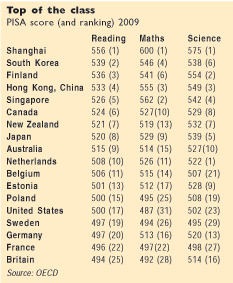From Toronto to Wroclaw, London to Rome, pupils and teachers have been returning to the classroom after their summer break. But this autumn, schools themselves are caught up in a global battle of ideas. In many countries education is at the forefront of political debate, and reformers desperate to improve their national performance are drawing examples of good practice from all over the world.
Why now? One answer is the sheer amount of data available on performance, not just within countries but between them. In 2000, the Programme for International Student Assessment (PISA) of the Organisation for Economic Cooperation and Development (OECD) — a club of rich industrial nations — began tracking academic attainment by age 15 in 32 countries. Many were shocked by where they came in the rankings. (For PISA’s latest figures, see table.) Other outfits, too, have been measuring how good or bad schools are. McKinsey, a consultancy, has monitored which education systems have improved most in recent years.
Technology has also made a difference. After a number of false starts, many people now believe the internet can make a real difference to educating children. Hence the success of institutions like America’s Khan Academy. Experimentation is also infectious; the more governments try things, the more others examine, and copy, the results.
The idea that good schooling is about spending money is one excuse that has been beaten back hardest. Such spending is highest in the United States — yet America lags behind other developed countries on overall outcomes in secondary education.
 Andreas Schleicher, head of analysis at PISA, thinks that only about 10 percent of the variation in pupil performance has anything to do with money. Many still insist, though, that social class makes a difference. Martin Johnson, an education trade unionist, points to Britain’s “inequality between classes, which is among the largest in the wealthiest nations” as the main reason why its pupils underperform. A review of reforms over the past decade by researchers at Oxford University supports him.
Andreas Schleicher, head of analysis at PISA, thinks that only about 10 percent of the variation in pupil performance has anything to do with money. Many still insist, though, that social class makes a difference. Martin Johnson, an education trade unionist, points to Britain’s “inequality between classes, which is among the largest in the wealthiest nations” as the main reason why its pupils underperform. A review of reforms over the past decade by researchers at Oxford University supports him.
Culture is certainly a factor. Many Asian parents pay much more attention to their children’s test results than Western parents do, and push their schools to succeed. Singapore, Hong Kong and South Korea sit comfortably at the top of McKinsey’s rankings.
So what are the secrets of success? Though there is no one template, four important themes emerge: decentralisation (handing power back to schools); a focus on underachieving pupils; a choice of different sorts of schools; and high standards for teachers.
Of the four chief elements of schools reform, diversity of supply is by far the most striking. From New York to Shanghai to Denmark, schools free of government control and run by non-state providers are adding quality to the mix. To date, they seem most successful where the state has been unwilling or unable to make a difference.
What is clear, however, is that the shiniest new academy will struggle without decent teachers. An emphasis on better teacher quality is a common feature of all reforms. Countries like Finland and South Korea make life easier for themselves by recruiting only elite graduates, and paying them accordingly.
Britain’s education secretary, Michael Gove says he wants to raise the degree threshold for teachers and offer “golden hellos” in areas of shortage, like science and language teaching. America has experimented at the state level with merit pay and payment by results, but often in the teeth of opposition from the teachers’ unions.
Excerpted and adapted from The Economist